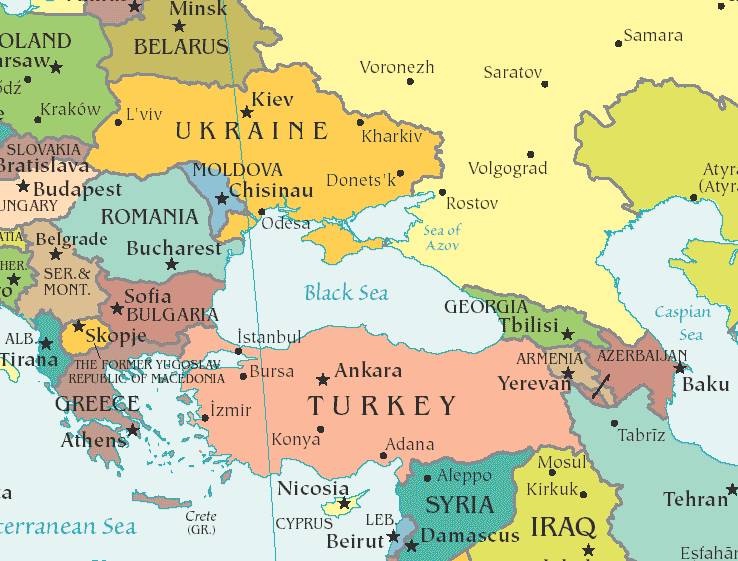
15 Cool Facts About the Black Sea
The Black Sea also known as Euxine Sea is located between Eastern Europe and Western Asia. As one of the oldest and most unique bodies of water in the world, the Black Sea is truly something to marvel at. Here are fifteen compelling facts about the Black Sea:
Facts about the Black Sea:
- It’s the world’s largest inland body of water. The Black Sea covers a whopping 163,000 square miles, which is more than the entire state of California. However, the Black Sea is different than most other inland bodies of water in that it’s also considered a marginal sea.
- It’s also the world’s largest meromictic basin. A meromictic lake is one that has layers of water that don’t mix together. Regular holomictic lakes, on the other hand, experience at least one period per year in which the surface waters mix in with the deep waters. Although there are meromictic lakes all around the globe, they’re quite rare. The ratio of meromictic lakes to holomictic lakes is about 1 to 1,000.
- The lower levels are nearly biologically dead. One of the fascinating features of the Black Sea is its lack of oxygen, which is the necessary element for life. Because oxygen can only be dissolved in the sea’s upper levels, everything below a depth of about 230-330 feet in the middle and 330-500 feet near the edge is basically a dead zone. Only certain bacteria can survive in these regions, which make up more than 90% of the deeper water.
- It’s mentioned in Greek mythology. Deemed the “Pontus Axeinus,” which translates to “Inhospitable Sea,” this body of water is referenced in many ancient myths. Once the ancient Greeks explored more of the area and colonized along the shores, they realized the waters weren’t as daunting as they’d previously thought, and they changed the name to exact opposite term, meaning “Hospitable Sea.”
- Some of the rocks are at least 540 million years old. Rocks along the area known as the Russian Platform date back to the Precambrian era, which is the earliest eon of the earth’s history. This period lasted from the formation of the solar system 4.6 billion years ago up until the formation of the first multicellular animals. To put it into perspective, the ancient rocks along the Black Sea were around for almost 300 years before dinosaurs even came onto the scene.
- It’s an earthquake hot zone. Although numerous earthquakes have been recorded in and around the Black Sea, the 1901 Black Sea earthquake (also called the Balchik earthquake in Bulgaria) had the highest recorded magnitude at 7.2. The mainshock caused a 1-16 foot tsunami that ravaged the Romanian and Bulgarian coasts. The aftershocks lasted four more years.
- The Maximum depth is 7,257 feet. That distance is longer than the Kentucky Derby. At 6,600 feet, the total race length is nine-tenths the length of the Black Sea’s maximum depth.
- It takes 2,500 years for the water to be completely recycled. There are many rivers that flow into the Black sea, including the Dunabe, Dniper, Southern Bug, Don, Kuban, Rioni, and Kizilirmak rivers. However, there is only one primary outflow: the Bosporus Strait, which leads to the Mediterranean Sea. Because the Bosporus is very slow flowing, it takes an estimated 2,500 years for the water in the Black Sea to be fully recycled.
- A giant undersea river flows beneath it. In 2010, scientist discovered a current of saline water flowing from the Mediterranean Sea, through the Bosphorus Strait, and along the seabed of the Black Sea. Although other undersea rivers have since been discovered, this one was the first in the world.
- According to one theory, Noah’s Ark ended up in the Black Sea. Some geologists claim that before the Mediterranean Sea flooded it with salt water, the Black Sea was a freshwater lake. Based on this theory, many people argue that this flood is the one mentioned in the biblical story of Noah’s Ark.
- Six different countries border it. Romania, Turkey, Bulgaria, Ukraine, Russia, and Georgia all share the Black Sea coastline. The coastal cities support a population of about 16 million people and bring in an additional 4 million tourists each year.
- Due to human activity, it remains one of the world’s most damaged marine areas. Maintaining the Black Sea’s extremely unique and delicate ecosystem is dependent upon the salinity (amount of salt), water level, and amount of nutrients. In the last several decades, human activity negatively affected all of these factors. Such activity includes manmade pollution, over-harvesting for fisheries, and an increased nutrient load.
- The coastline is three-fifths as long as the diameter of Earth. At roughly 8,000 kilometers or nearly 5,000 miles, the coastline of the Black Sea is about .6 times the length of Earth’s diameter at the Equator.
- Once, it turned turquoise. There’s a famous photograph of the Black Sea from above that shows turquoise swirls all across the water’s surface. Large blooms of phytoplankton caused this incredible phenomenon.
- The same event that caused its formation also caused the formation of the Island of Great Britain. Flooding from glacier melt half a million years ago covered the strip of land that connected what is now Great Britain to the rest of mainland Europe, which eventually caused the land mass to break away. This same flood also filled up the Black Sea